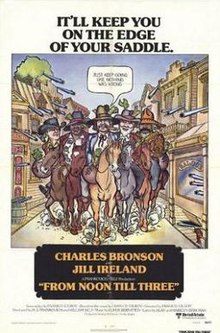Plot
In the late 19th century American West, a gang of bank robbers, including Graham Dorsey (Charles Bronson), is off to rob a small-town bank, but Graham is having second thoughts: he's had a nightmare in which the gang was wiped out during the robbery attempt. Worse, Graham's horse broke a leg and the gang members have to get another. They try to steal a horse at the ranch of the widow Amanda Starbuck (Jill Ireland). Amanda, suspicious of the men, denies having a horse. Graham checks out the barn and finds a horse, but still afraid of disaster, he lies to his men and agrees to wait three hours at the ranch for their return. It turns out he has another reason for wanting to stay behind though: he wants to force himself on Mrs. Starbuck. Amanda resists rather inventively; simply lies still, fully clothed. This frustrates Graham, who decides on a ruse. He pretends he is impotent, hoping to play on Amanda's sympathy. The deception works, and they make love three times.
As time passes, Graham and Amanda have a long, thoughtful discussion talking of their past lives, as well as their hopes and ambitions - Graham even wants to go straight and work in a bank. They even dance to Amanda's music box, with Graham wearing Mr. Starbuck's old tuxedo. A neighbor boy stops by to tell Amanda about an attempted bank robbery. The bank robbers from Graham's gang were caught and were going to be hanged in town that afternoon. She thinks Graham should ride out and help them. Graham thinks this is a way for him to be able to stay with her and get away from the gang. After much coercing he decides to play along and rides out, intending only to have a long nap. But this is shattered when the posse rides into sight, spotting Graham and giving chase. Graham eludes them when he comes upon a traveling dentist, exchanges clothes with him at gunpoint, and steals his horse and wagon. The unfortunate Dr. Finger is taken for Graham and shot dead. The posse, recognizing Mr. Starbuck's horse and tux, bring the body back to the Starbuck ranch. Amanda, seeing what she thinks is Graham's body faints. But Graham does not get away clean: it turns out Dr. Finger was a quack, and the first person Graham encounters after his escape was one of Dr. Finger's dissatisfied customers. He is put into prison on a year-long sentence for Dr. Finger's crimes.
At first Amanda is ostracized by the townspeople. But an impassioned speech proclaiming her true love for him does a remarkable trick: the townspeople not only forgive her, they see a remarkable story in that of Graham and Amanda. This story forms the basis of a legend, one that spawns a popular book, From Noon Till Three, dime novels, a stage play, and even a popular song, "Hello and Goodbye," set to the tune of Amanda's music box. The legend of Graham and Amanda becomes bigger than the reality of the two, and with her book a worldwide best seller it makes Amanda a wealthy woman. Graham, who reads the book while in prison, is amused by the distortions: Graham is described as being 6'3" (1.90 m), Southern, and very handsome; he is, in fact, none of these. After serving his time he is eager to renew his relationship with Amanda.
A disguised Graham takes one of Amanda's guided tours of her ranch, and stays behind, intending to reveal himself. When he does so, Amanda does not recognize him and becomes frightened. When he mentions details of their time together, she keeps noting, "It's in the book." It is only when Graham shows her "something that's not in the book" that Amanda believes him. But instead of joy, Amanda is confused and worried. If word got out that Graham was alive, the legend of Graham and Amanda would be done for. Even Graham's suggestion that he live with her incognito is no good; after all, if Amanda were to live with another man, the legend would still be destroyed. The encounter ends up with Amanda pointing a gun at Graham ... but at the last second she decides to shoot herself.
Graham is heartbroken. Not only has he lost Amanda, the secret of his real identity is lost for good. He tries to forget what has happened, but there are reminders everywhere. He hears "their song" at a local saloon, and walks in on a stage production of From Noon Till Three. Worse, people he knew slightly laugh when he says he is Graham, since he looks nothing like his description in the book. Ultimately he is arrested and put in an insane asylum, where he meets the only people who believe him: his fellow inmates. He seems relieved.

High Noon is a 1952 American Western film produced by Stanley Kramer from a screenplay by Carl Foreman, directed by Fred Zinnemann, and starring Gary Cooper. The plot, which occurs in real time, centers on a town marshal whose sense of duty is tested when he must decide to either face a gang of killers alone, or leave town with his new wife.

The Dalton Gang was a group of outlaws in the American Old West during 1890–1892. It was also known as The Dalton Brothers because four of its members were brothers. The gang specialized in bank and train robberies. During an attempted double bank robbery in Coffeyville, Kansas in 1892, two of the brothers and two other gang members were killed; Emmett Dalton survived, was captured, and later pleaded guilty to second-degree murder, although he later asserted that he never fired a shot during the robbery. He was paroled after serving 14 years in prison.

William Brocius, better known as Curly Bill Brocius, was an American gunman, rustler and an outlaw Cowboy in the Cochise County area of the Arizona Territory during the late 1870s and early 1880s. His name is likely an alias or nickname, and some evidence links him to another outlaw named William "Curly Bill" Bresnaham, who was convicted of an 1878 attempted robbery and murder in El Paso, Texas.

'Neath the Arizona Skies is a 1934 Western film directed by Harry L. Fraser, produced by Lone Star Productions, released by Monogram Pictures and starring John Wayne. Wayne's character attempts to locate a little girl's father, so that she may claim a $50,000 Indian oil claim. The film co-stars Sheila Terry and Shirley Jean Rickert. George "Gabby" Hayes played a featured character with a speaking role, but his name was omitted from the cast list in the opening credits.

Harvey Alexander Logan, also known as Kid Curry, was an American outlaw and gunman who rode with Butch Cassidy and the Sundance Kid's infamous Wild Bunch gang during the late 19th and early 20th centuries. Despite being less well-known than his fellow gang members, he has since been referred to as "the wildest of the Wild Bunch", having reputedly killed at least nine law enforcement officers in five shootings and another two men in other instances. He was involved in numerous shootouts with police and civilians and participated in several bank and train robberies with various gangs during his outlaw days.

Good Day for a Hanging is a 1959 American B Western film directed by Nathan H. Juran and starring Fred MacMurray and Margaret Hayes.

The Pleasant Valley War, sometimes called the Tonto Basin Feud, or Tonto Basin War, or Tewksbury-Graham Feud, was a range war fought in Pleasant Valley, Arizona in the years 1882–1892. The conflict involved two feuding families, the Grahams and the Tewksburys. The Grahams were ranchers, while the Tewksburys, who were part Native American, started their operations as cattle ranchers before branching out to sheep.

Chato's Land is a 1972 Western Technicolor film directed by Michael Winner, starring Charles Bronson and Jack Palance.

Gratton Hanley "Grat" Dalton was an American outlaw in the American Old West. He was one of three brothers in the Dalton Gang, led by his younger brother Bob Dalton. Both brothers were killed during a shootout in an ill-fated raid on two banks in Coffeyville, Kansas. Their brother Emmett Dalton survived to be convicted and imprisoned for fourteen years.

Jubal is a 1956 American Western film directed by Delmer Daves and starring Glenn Ford, Ernest Borgnine, Rod Steiger, Valerie French, and Felicia Farr. Shot in CinemaScope, it was one of the few adult westerns in the 1950s and is described as Othello on the Range. The supporting cast features Noah Beery Jr., Charles Bronson and Jack Elam.

Posse from Hell is a 1961 American Western film directed by Herbert Coleman and starring Audie Murphy and John Saxon.
Gunsmoke: The Long Ride is a 1993 American Western television film based on the series Gunsmoke, in which the main character, Matt Dillon is again played by James Arness.
The Man Called Noon is a 1973 film directed by Peter Collinson. It stars Richard Crenna and Stephen Boyd. It is based on a 1970 Louis L'Amour novel of the same name.

Robert Rennick Dalton was an American outlaw in the American Old West. Beginning in 1891, he led the Dalton Gang, whose varying members included three of his brothers. They were known for robbing banks, stagecoaches and trains, primarily in Kansas and Oklahoma Territory, quickly attracting pursuit by lawmen.

Top Gun is a 1955 American Western film directed by Ray Nazarro. The plot concerns an ex-gunslinger who arrives in a small town warning of an impending attack by his old gang. The film features Rod Taylor in one of his first American roles.

The Battleground Gunfight, also known as the Battleground Shootout, was a gunfight between a posse of American lawmen and the Smith Gang. It was fought on October 8, 1901, within Arizona Territory's Fort Apache Indian Reservation, at a clearing in the forest known today as the "Battleground". Nine Arizona Rangers and deputies caught up with the cattle rustler Bill Smith and his gang. During a long exchange of gunfire that followed, Ranger Carlos Tafolla and Deputy Bill Maxwell were killed and one or two of the outlaws may have been wounded. In the end, the Smith Gang escaped the posse and fled into Mexico.
The Smith Gang was a band of American cattle rustlers who operated in the Southwest during the late 1890s to 1901. The gang was founded by Bill Smith and included six others, mainly Bill's family members. After an encounter with the law in Arizona Territory, known as the Battleground Gunfight, the Smith Gang was forced to escape to Mexico in October 1901.

Feuds in the United States deals with the phenomena of historic blood feuding in the United States. These feuds have been numerous and some became quite vicious. Often, a conflict which may have started out as a rivalry between two individuals or families became further escalated into a clan-wide feud or a range war, involving dozens—or even hundreds—of participants. Below are listed some of the most notable blood feuds in United States history, most of which occurred in the Old West.

The Skeleton Canyon shootout was a gunfight on August 12, 1896, between members of the High Five Gang and a posse of American lawmen. Following a failed robbery on August 1 of the bank in Nogales, Arizona, the High Fives headed east and split up. The gang's leader, Black Jack Christian, and George Musgrave got away.

Empty Holsters is a 1937 American Western film directed by B. Reeves Eason and written by John T. Neville. The film stars Dick Foran, Patricia Walthall, Emmett Vogan, Glenn Strange, Anderson Lawler and Wilfred Lucas. The film was released by Warner Bros. on July 10, 1937.

















